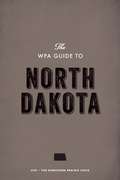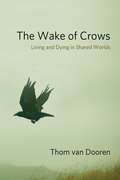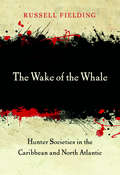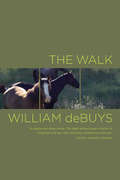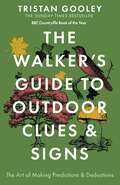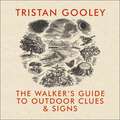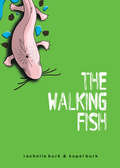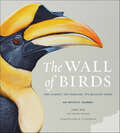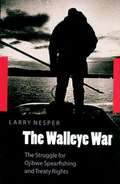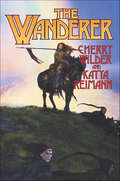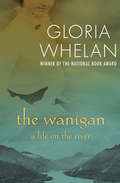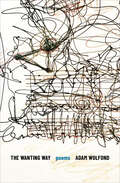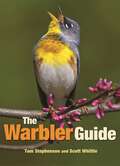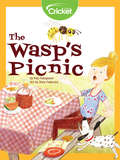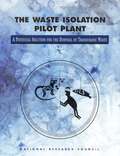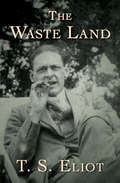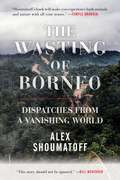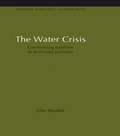- Table View
- List View
The WPA Guide to North Dakota
by Federal Writers' ProjectDuring the 1930s in the United States, the Works Progress Administration developed the Federal Writers' Project to support writers and artists while making a national effort to document the country's shared history and culture. The American Guide series consists of individual guides to each of the states. Little-known authors-many of whom would later become celebrated literary figures-were commissioned to write these important books. John Steinbeck, Saul Bellow, Zora Neale Hurston, and Ralph Ellison are among the more than 6,000 writers, editors, historians, and researchers who documented this celebration of local histories. Photographs, drawings, driving tours, detailed descriptions of towns, and rich cultural details exhibit each state's unique flavor.According to the WPA Guide to North Dakota, there is more to the Northern Prairie State than meets the eye. Primarily an agricultural state, cattle ranching and the pioneer spirit are ever-present in this guide. Also, beautiful photographs of the Great Plains make this a visually pleasing guide the Peace Garden State.
The WTO and the Environment: Development of competence beyond trade (Routledge Research in International Economic Law)
by James WatsonThis book is a review of the development of the WTO dispute resolution procedure and the power and influence it has gained over the practises of the member countries as well as in other international treaties. The book addresses the development of environmental competency in the WTO and examines the arguments of those who oppose WTO rule making with impacts on the environment. The WTO’s interactions with multilateral environmental agreements are considered and recent WTO cases including the 2011 US/Mexico tuna dispute and the US sea turtles decision are analysed in detail. In examining how an international organisation which was established with a specific purpose in mind has come to interact in fields beyond its original remit, James Watson demonstrates how the dispute resolution system at the WTO has come to work in a judicialised manner, operating with an informal system of precedent. This has led to the contracting parties placing more reliance on the decisions of the dispute panels and appeal body when considering policy options, with WTO rulings increasingly influencing the behaviour of national legislatures in regard to the environment. The book goes on to make concrete recommendations, based on existing practise in the WTO dispute resolution procedure, which could enhance decision making in environmental cases heard by the WTO. The book argues that this could be achieved with straightforward amendments to the WTO, based on existing practices endorsed under the WTO for other policy considerations. The WTO and the Environment will be of particular interest to academics and students of International and Environmental law.
The Wacky World of Living Things! (Fact Attack Ser.)
by Melvin Berger Gilda BergerThis is the first book in a brand-new series featuring TONS of awesomely incredible, weird, and crazy facts!Did you know crickets have ears on their knees? That snakes never close their eyes? Or that no plant has black flowers? Discover these incredible facts and more in the first Fact Attack book, all about plants and animalsFact Attack is an exploration of the most amazing and awe-inspiring plant and animal facts. Heavily designed with different approaches on each page, the style is dynamic, fresh, and in your face. Whether you flip to a page to learn a digestible fact or read it from beginning to end, this is a book a reader will return to time and again.
The Wake of Crows: Living and Dying in Shared Worlds (Critical Perspectives on Animals: Theory, Culture, Science, and Law)
by Thom van DoorenCrows can be found almost everywhere that people are, from tropical islands to deserts and arctic forests, from densely populated cities to suburbs and farms. Across these diverse landscapes, many species of crow are doing well: their intelligent and adaptive ways of life have allowed them to thrive amid human-driven transformations. Indeed, crows are frequently disliked for their success, seen as pests, threats, and scavengers on the detritus of human life. But among the vast variety of crows, there are also critically endangered species that are barely hanging on to existence, some of them the subjects of passionate conservation efforts.The Wake of Crows is an exploration of the entangled lives of humans and crows. Focusing on five key sites, Thom van Dooren asks how we might live well with crows in a changing world. He explores contemporary possibilities for shared life emerging in the context of ongoing processes of globalization, colonization, urbanization, and climate change. Moving among these diverse contexts, this book tells stories of extermination and extinction alongside fragile efforts to better understand and make room for other species. Grounded in the careful work of paying attention to particular crows and their people, The Wake of Crows is an effort to imagine and put into practice a multispecies ethics. In so doing, van Dooren explores some of the possibilities that still exist for living and dying well on this damaged planet.
The Wake of the Whale: Hunter Societies in the Caribbean and North Atlantic
by Russell FieldingDespite declining stocks and health risks, island communities in the Caribbean and North Atlantic still use traditional methods to hunt whales and dolphins for food. Russell Fielding presents the art, history, and purpose of whaling in these different cultures and describes what their future might look like as modern realities take hold.
The Walk
by William DebuysIn The Walk, William deBuys writes about personal loss and the power of the landscape to nurture the recovery of hope. The book consists of three interrelated essays that move from a period of strife in the author's life to a kind of limbo and eventually to a place of peace. The setting is deBuys' small farm in New Mexico's Sangre de Cristo Mountains. Each morning, he takes the same walk through the woods, arriving, as he describes in the first essay, at a clarity that comes from looking at the same vantage point for years. The middle essay, "Geranium," takes its name from a mare deBuys had to put down, and whose remains become one with the forest. In the final essay, deBuys reflects on drought, the loss of a friend, and the resurgence of land and hope. Contemplative, compassionate, and quietly humorous, The Walk is nature writing at its finest.
The Walker's Guide to Outdoor Clues and Signs: Explore the great outdoors from your armchair
by Tristan Gooley'It's like being given some sort of magical text... eye-opening and invaluable.' India Knight, Sunday Times'Even the intrepid Bear Grylls could learn a trick or two from this book' The TimesThe ultimate guide to what the land, sun, moon, stars, trees, plants, animals, sky and clouds can reveal - when you know what to look for. Includes over 850 outdoor clues and signs for you to enjoy the wonders of the outdoors from your living room. This top ten bestseller is the result of Tristan Gooley's two decades of pioneering outdoors experience and six years of instructing, researching and writing. It includes lots of outdoor clues and signs that will not be found in any other book in the world. As well as the most comprehensive guide to natural navigation for walkers ever compiled, it also contains clues for weather forecasting, tracking, city walks, coast walks, night walks and dozens of other areas.
The Walker's Guide to Outdoor Clues and Signs: Their Meaning and the Art of Making Predictions and Deductions
by Tristan Gooley**From the bestselling author of THE NATURAL EXPLORER and HOW TO READ WATER, the Sunday Times Book Of The Year**2015 BBC Countryfile Magazine Country Book of the Year and winner of the Outdoor Book of the Year at The Great Outdoors Awards 2015'Even the intrepid Bear Grylls could learn a trick or two from this book' The TimesThe ultimate guide to what the land, sun, moon, stars, trees, plants, animals, sky and clouds can reveal - when you know what to look for. Includes over 850 outdoor clues and signs. This top ten bestseller is the result of Tristan Gooley's two decades of pioneering outdoors experience and six years of instructing, researching and writing. It includes lots of outdoor clues and signs that will not be found in any other book in the world. As well as the most comprehensive guide to natural navigation for walkers ever compiled, it also contains clues for weather forecasting, tracking, city walks, coast walks, night walks and dozens of other areas.(P)2019 Hodder & Stoughton Limited
The Walking Fern
by Matilda Joslyn GageMatilda Joslyn Gage a famous Womans Rights suffragist also wrote many books, speaches, stories and articles.In the 1800's The Walking Fern, is a short story about two young ladies who go out in search of a rare fern, and meet a strange man with a secret past.
The Walking Fish
by Rachelle Burk Kopel BurkA humorous, exciting tale of an ordinary girl who makes an extraordinary scientific discovery--a blind fish that walksWhen seventh-grader Alexis catches an unusual fish that looks like a living fossil, she sets off a frenzied scientific hunt for more of its kind. Alexis and her friend Darshan join the hunt, snorkeling, sounding the depths of Glacial Lake, even observing from a helicopter and exploring a cave. All the while, they fight to keep the selfish Dr. Mertz from claiming the discovery all for himself. When Alexis follows one final hunch, she risks her life and almost loses her friend. Walking Fish is a scientific adventure that provides a perfect combination of literacy and science.
The Wall of Birds: One Planet, 243 Families, 375 Million Years
by Jane Kim Thayer WalkerA celebration of the diversity and evolution of birds, as depicted in the Cornell Lab of Ornithology's magnificent 2,500-square-foot Wall of Birds mural by artist Jane Kim.Part homage, part artistic and sociological journey, The Wall of Birds tells the story of birds' remarkable 375-million-year evolution. With a foreword by John W. Fitzpatrick, director of the Cornell Lab of Ornithology, and full of lush photographs of gorgeous life-size birds painted in exacting detail, The Wall of Birds lets readers explore these amazing creatures family by family and continent by continent. Throughout, beautifully crafted narratives and intimate artistic reflections tell of the evolutionary forces that created birds' dazzling variety of forms and colors, and reveal powerful lessons about birds that are surprisingly relevant to contemporary human challenges.From the tiny five-inch Marvelous Spatuletail hummingbird to the monstrous thirty-foot Yutyrannus, The Wall of Birds is a visual feast, essential for bird enthusiasts, naturalists, and art lovers alike.
The Walleye War: The Struggle for Ojibwe Spearfishing and Treaty Rights
by Larry NesperFor generations, the Ojibwe bands of northern Wisconsin have spearfished spawning walleyed pike in the springtime. The bands reserved hunting, fishing, and gathering rights on the lands that would become the northern third of Wisconsin in treaties signed with the federal government in 1837, 1842, and 1854. Those rights, however, would be ignored by the state of Wisconsin for more than a century. When a federal appeals court in 1983 upheld the bands' off-reservation rights, a deep and far-reaching conflict erupted between the Ojibwe bands and some of their non-Native neighbors. Starting in the mid-1980s, protesters and supporters flocked to the boat landings of lakes being spearfished; Ojibwe spearfisher-men were threatened, stoned, and shot at. Peace and protest rallies, marches, and ceremonies galvanized and rocked the local communities and reservations, and individuals and organizations from across the country poured into northern Wisconsin to take sides in the spearfishing dispute. From the front lines on lakes to tense, behind-the-scenes maneuvering on and off reservations, The Walleye War tells the riveting story of the spearfishing conflict, drawing on the experiences and perspectives of the members of the Lac du Flambeau reservation and an anthropologist who accompanied them on spearfishing expeditions. We learn of the historical roots and cultural significance of spearfishing and off-reservation treaty rights and we see why many modern Ojibwes and non-Natives view them in profoundly different ways. We also come to understand why the Flambeau tribal council and some tribal members disagreed with the spearfishermen and pursued a policy of negotiation with the state to lease the off-reservation treaty rights for fifty million dollars. Fought with rocks and metaphors, The Walleye War is the story of a Native people's struggle for dignity, identity, and self-preservation in the modern world. Larry Nesper an assistant professor of anthropology at the University of Wisconsin-Madison.
The Walter Hagen Story by The Haig, Himself
by Walter Hagen“I never wanted to be a millionaire—I just wanted to live like one…”—Walter HagenTHIS IS Walter Hagen’s own story of the two decades when he ruled the golfing world as King. Hagen not only won a major tournament every year for twenty years—a record never even approached by any other golfer—but his personality dominated the game over that period. Before he came along, professional golfers had the status of hired hands. The Haig was the man who crashed the front door of the clubhouses, and he brought along with him the entire fraternity of golf professionals.He was a magnificent showman and, in addition to changing the social standing of the golf pro, his competitive skill and flamboyant character built up public in interest in golf throughout the world. The result was perhaps best expressed in Gene Sarazen’s own memoirs when he said, “All the professionals who have a chance to go after the big money today should say silent thanks to Walter Hagen each time they stretch a check between their fingers. It was Walter Hagen who made professional golf what it is.”The picture of sartorial elegance, he became the fashion plate that others copied for years. He was the honoured guest of emperors and the tutor and personal friend of the young Edward, then Prince of Wales. An idol both at home and abroad (he won the U.S. Open twice, made the P.G.A. Championship almost his exclusive personal property through the twenties, and won the British Open four times), he toured the world with Joe Kirkwood as the most outstanding ambassador of good will that golf ever produced. All this and much more is set down in this book in a style which has the same swashbuckling flavour as characterized his long playing career.
The Wanderer
by Katya Reimann Cherry WilderCherry Wilder's The Rulers of Hylor series established a detailed and intricate fantasy world. Katya Riemann completed and polished this last Hylor novel, a tale of warring kingdoms, treacherous advisers and generational conflicts, set in a world of rich physical beauty, vibrant life and a realism leavened with occasional and startling magic.Gael Maddoc, the child of struggling peasants, leaps at the chance when she is offered training as a kedran, a mounted soldier. She wins glory bringing her charges home safe across a huge desert, seeking aid from the Shee. But the Shee--the dwindling Fair Folk--then recruit her for their own purposes. Her nascent magical talents and her resourcefulness show her to be the Wanderer, a legendary figure for whom they've been waiting.At the Publisher's request, this title is being sold without Digital Rights Management Software (DRM) applied.
The Wanigan: A Life on the River
by Gloria WhelanTo save his family, a logger goes down the river—and brings along his wife and daughter When Annabel&’s father sells their house in Detroit, she is thrilled by the idea of life on a farm. But when they reach their little plot of land, she sees that her daddy has been swindled. The rocky ground is hard and unforgiving, and nothing will grow there. Ruined, her father has no choice but to take the only job he can find: chopping down trees in the lush Michigan forest. For Annabel, life in the camp is dreary—but it is about to get a whole lot worse. When her father is chosen to accompany the year&’s load of logs as it floats down the river, Annabel and her mother take up residence in the wanigan, the floating cookshack that follows the men. This rough-hewn one-room cabin will house them for three months. As uncomfortable as it is, Annabel learns that sometimes, a river can be a home.
The Wanting Way: Poems
by Adam WolfondIn The Wanting Way, the second book in Multiverse—a literary series written and curated by the neurodivergent—Adam Wolfondproves more than willing to “extend the choreography.”In fact, his entire thrust is out and toward. Each poem moves out along its own underutilized pathway, awakening unseen dimensions for the reader like a wooded night walk suddenly lit by fireflies. And as each path elaborates itself, Wolfond’s guiding hand seems always to stay held out to the reader, inviting them further into a shared and unprecedented unfolding. The Wanting Way is actually a confluence of diverse ways—rallies, paths, waves, jams, streams, desire lines—that converge wherever the dry verbiage of the talking world requires hydration. Each poem is an invitation to bathe in the play of languaging. And each poem is an invitation to a dance that’s already happening, called into motion by the objects and atmospheres of a more-than-human world. Wolfond makes space for new poetics, new choreographies, and new possibilities toward forging a consensual—felt and feeling—world where we might find free disassembly and assembly together. There is a neurodivergent universe within this one, and Wolfond’s poems continuously pull back the unnecessary veil between human and nature.
The War Against the Greens: The "Wise-Use" Movement, the New Right, and Anti-Environmental Violence
by David HelvargA shadowy backlash against environmentalists has begun to emerge in America, the most visible element of which calls itself the "Wise Use" movement. Among its stated goals are the unregulated use of timber, oil, gas, minerals, and range land, and the abolition of all environmental laws and agencies.
The Warbler Guide
by Scott Whittle Tom StephensonA field guide that revolutionizes warbler identificationWarblers are among the most challenging birds to identify. They exhibit an array of seasonal plumages and have distinctive yet oft-confused calls and songs. The Warbler Guide enables you to quickly identify any of the 56 species of warblers in the United States and Canada. This groundbreaking guide features more than 1,000 stunning color photos, extensive species accounts with multiple viewing angles, and an entirely new system of vocalization analysis that helps you distinguish songs and calls.The Warbler Guide revolutionizes birdwatching, making warbler identification easier than ever before. For more information, please see the author videos on the Princeton University Press website.Covers all 56 species of warblers in the United States and CanadaVisual quick finders help you identify warblers from any angleSong and call finders make identification easy using a few simple questionsUses sonograms to teach a new system of song identification that makes it easier to understand and hear differences between similar speciesDetailed species accounts show multiple views with diagnostic points, direct comparisons of plumage and vocalizations with similar species, and complete aging and sexing descriptionsNew aids to identification include song mnemonics and icons for undertail pattern, color impression, habitat, and behaviorIncludes field exercises, flight shots, general identification strategies, and quizzesA complete, page-by-page audio companion to all of the 1,000-plus songs and calls covered by the book is available for purchase and download from the Cornell Lab of Ornithology's Macaulay Library by using the link at www.TheWarblerGuide.com
The Warming Papers: The Scientific Foundation for the Climate Change Forecast
by David ArcherChosen for the 2011 ASLI Choice - Honorable Mention (History Category) for a compendium of the key scientific papers that undergird the global warming forecast. Global warming is arguably the defining scientific issue of modern times, but it is not widely appreciated that the foundations of our understanding were laid almost two centuries ago with the postulation of a greenhouse effect by Fourier in 1827. The sensitivity of climate to changes in atmospheric CO2 was first estimated about one century ago, and the rise in atmospheric CO2 concentration was discovered half a century ago. The fundamentals of the science underlying the forecast for human-induced climate change were being published and debated long before the issue rose to public prominence in the last few decades. The Warming Papers is a compendium of the classic scientific papers that constitute the foundation of the global warming forecast. The paper trail ranges from Fourier and Arrhenius in the 19th Century to Manabe and Hansen in modern times. Archer and Pierrehumbert provide introductions and commentary which places the papers in their context and provide students with tools to develop and extend their understanding of the subject. The book captures the excitement and the uncertainty that always exist at the cutting edge of research, and is invaluable reading for students of climate science, scientists, historians of science, and others interested in climate change.
The Wasp's Picnic
by Kay HaugaardStevie loves bugs—or insects, as he would say. He has lots of books about them and is always looking to see more! When the family has a picnic, a yellow jacket decides to join them, which scares their mom! Can Stevie convince his family that even though wasps are scary, they aren’t all bad?
The Waste Isolation Pilot Plant: A Potential Solution for the Disposal of Transuranic Waste
by Committee on the Waste Isolation Pilot PlantThis volume discusses the readiness of the U.S. Department of Energy's (DOE) Waste Isolation Pilot Plant (WIPP) facility near Carlsbad, New Mexico, to serve as a geological repository for transuranic radioactive waste. WIPP is located in a Permian-age bedded salt deposit 658 meters below the surface. The committee has long reviewed DOE's readiness efforts, now aimed at demonstrating compliance with U.S. Environmental Protection Agency regulations. Site characterization studies and performance assessment modeling are among the topics considered in this volume.
The Waste Land: 75th Anniversary Edition (Longman Literature Guides)
by T. S. EliotThe masterpiece of Modernist poetry, offering a profound and kaleidoscopic meditation on Western life in the aftershocks of World War I. Famous for juxtaposing Eastern cultures with Western literary references, T. S. Eliot&’s The Waste Land has been celebrated for its eloquence, depth of meaning, and endlessly interwoven subtleties. Rich with allusions to the religious texts of Hinduism and Buddhism, Western literature, and Eliot&’s own life, the poem continues to provoke, inspire, and delight. First published in 1922, The Waste Land quickly ascending to the status of literary classic. It is widely considered to be Eliot&’s finest work, representing maturity in his style and confidence in both expression and research. This ebook has been professionally proofread to ensure accuracy and readability on all devices.
The Waste Makers
by Bill Mckibben Vance PackardAn exposé of "the systematic attempt of business to make us wasteful, debt-ridden, permanently discontented individuals," The Waste Makers is Vance Packard's pioneering 1960 work on how the rapid growth of disposable consumer goods was degrading the environmental, financial, and spiritual character of American society. The Waste Makers was the first book to probe the increasing commercialization of American life--the development of consumption for consumption's sake. Packard outlines the ways manufacturers and advertisers persuade consumers to buy things they don't need and didn't know they wanted, including the two-of-a-kind of everything syndrome--"two refrigerators in every home"--and appeals to purchase something because it is more expensive, or because it is painted in a new color. The book also brought attention to the concept of planned obsolescence, in which a "death date" is built into products so that they wear out quickly and need to be replaced. By manipulating the public into mindless consumerism, Packard believed that business was making us "more wasteful, imprudent, and carefree in our consuming habits," which was using up our natural resources at an alarming rate. A prescient book that predicted the rise of American consumer culture, this all new edition of The Waste Makers features an introduction by best-selling author Bill McKibben. Vance Packard (1914-1996) was an American journalist, social critic, and best-selling author. Among his other books were The Hidden Persuaders, about how advertisers use psychological methods to get people to buy the products they sell; The Status Seekers, which describes American social stratification and behavior; and The Naked Society, about the threats to privacy posed by new technologies.
The Wasting of Borneo: Dispatches from a Vanishing World
by Alex ShoumatoffAcclaimed naturalist Alex Shoumatoff issues a worldwide call to protect the drastically endangered rainforests of BorneoIn his eleventh book, but his first in almost two decades, seasoned travel writer Alex Shoumatoff takes readers on a journey from the woods of rural New York to the rain forests of the Amazon and Borneo, documenting both the abundance of life and the threats to these vanishing Edens in a wide-ranging narrative.Alex and his best friend, Davie, spent their formative years in the forest of Bedford, New York. As adults they grew apart, but bonded by the “imaginary jungle” of their childhood, Alex and Davie reunited fifty years later for a trip to a real jungle, in the heart of Borneo. During the intervening years, Alex had become an author and literary journalist, traveling the world to bring to light places, animals, and indigenous cultures in peril. The two reconnect and spend three weeks together on Borneo, one of the most imperiled ecosystems on earth. Insatiable demand for the palm oil ubiquitous in consumer goods is wiping out the world’s most ancient and species-rich rain forest, home to the orangutan and countless other life-forms, including the Penan people, with whom Alex and Davie camp. The Penan have been living in Borneo’s rain forest for millennia, but 90 percent of the lowland rain forest has already been logged and burned to make way for vast oil-palm plantations. Among the most endangered tribal people on earth, the Penan are fighting for their right to exist.Shoumatoff condenses a lifetime of learning about what binds humans to animals, nature, and each other, culminating in a celebration of the Penan and a call for Westerners to address the palm-oil crisis and protect the biodiversity that sustains us all.
The Water Crisis: Constructing solutions to freshwater pollution (Natural Resource Management Set Ser.)
by Julie StaufferModern society too often views water as a convenient vehicle for disposing of waste � and the results are becoming increasingly apparent. Analysis of freshwater supplies frequently reveals disturbing levels of pollution, including human waste, heavy metals and synthetic chemicals, to the detriment of our health, and the health of entire ecosystems. The Water Crisis examines the roots of freshwater pollution � urbanization, industrialization and intensive farming � supported by case studies from the Rhine and the Great Lakes. It explores the impact of major pollutants and discusses methods of prevention. The final section provides a detailed overview of possible solutions, including soil-based treatment systems and constructed wetlands. A separate chapter is devoted to the important issue of groundwater pollution. Practical concise and accessible, this is ideal for students in environmental studies and environmental science, biology and geography, and general readers. Originally published in 1998
